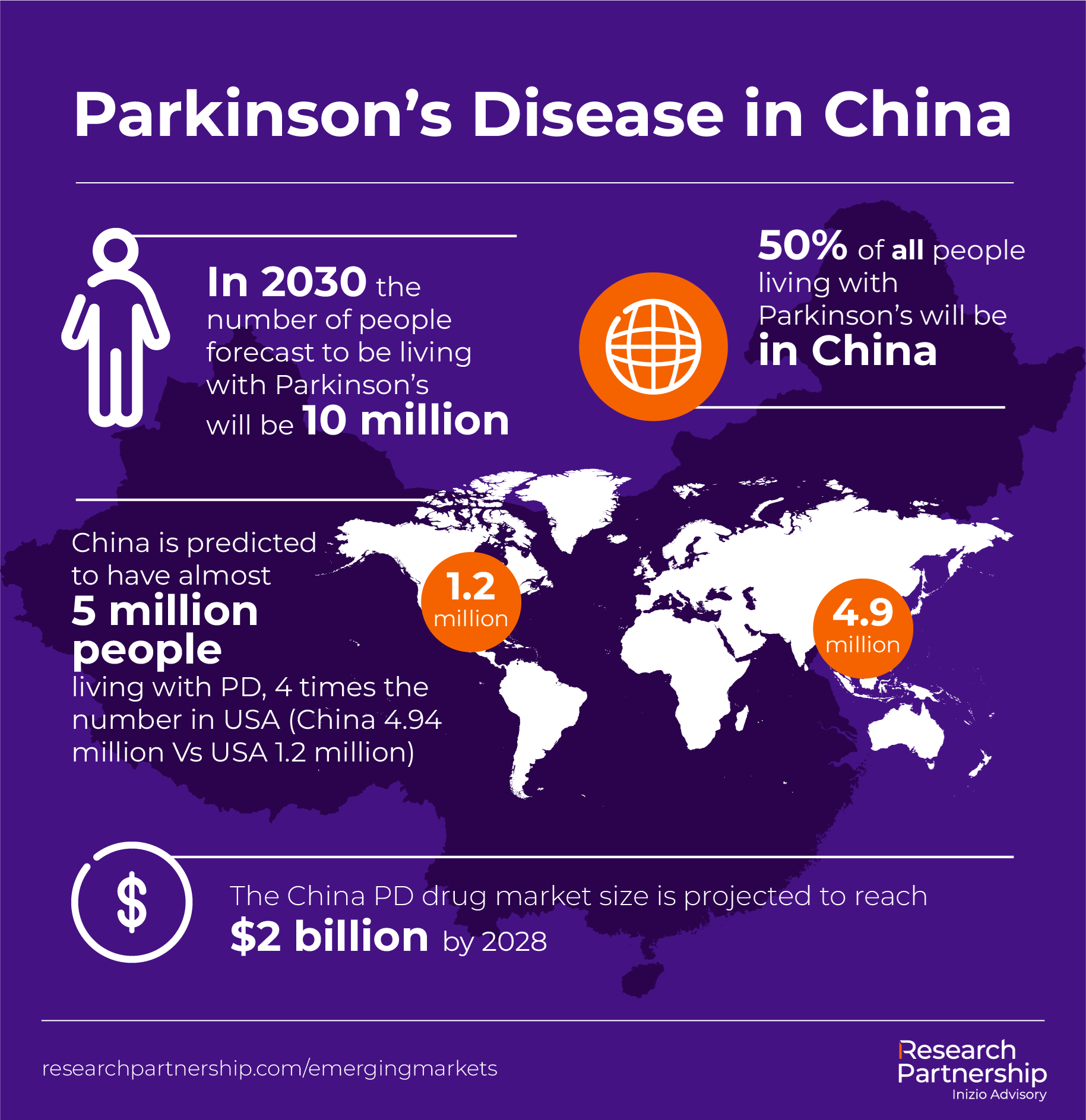Trends and opportunities in healthcare across emerging markets
There are many reasons for healthcare businesses to continue to pursue new sources of growth in emerging markets. IQVIA, for example, expects compound annual growth of 5-8% at invoice price levels in ‘‘pharmerging’’ markets between 2022 and 2026 (constant US$ at Q2 2021 exchange rates), compared with 2-5% in developed markets.
The fundamental growth drivers in emerging markets are still very much present and correct, including aging populations, shifting disease patterns and the rise of the middle class. By 2050, for example, the number of people aged 65 years or over globally is projected to double to more than 1.5 billion. In China alone, a key focus of emerging-market strategies in healthcare, the forecast is that 28% of a huge population will be aged 60-plus by 2028.
In parallel, there is a marked shift in emphasis from communicable to non-communicable diseases (NCDS), including the repercussions of changing lifestyles and diets. Worldwide, the prevalence of chronic NCDs is expected to increase by 40% between now and 2030, accounting for nearly 80% of all deaths in people aged 60 years or over. Rapidly aging populations make the challenges and costs of NCDs all the more critical.
China is again a prime example. By 2030, the country’s Parkinson’s disease (PD) population could number 4.9 million, accounting for half of all PD cases worldwide. This might constitute a market worth US$2 billion, just for one condition in one country. Small wonder 97 clinical trials for PD are currently ongoing in China.

The patient as stakeholder
The primacy of out-of-pocket (OOP) payments in many emerging markets is another binding characteristic that shapes healthcare business strategies, particularly in terms of segmentation. While OOP expenditure in emerging markets is on the decline overall, it still makes up 35% on average of overall healthcare spend, compared with 12% on average in developed markets.
This reinforces the patient’s status as a co-payer and a significant influence on healthcare value propositions. The rise of a middle class with relatively high disposable incomes in many emerging markets means there is more affordability than ever before to fund premium-priced healthcare products and services.
COVID-19, while hitting health, healthcare sustainability and household budgets hard in emerging markets, has also sharpened consumer concerns about personal health. For example, a BCG survey in May/June 2021 found that the proportion of consumers interested in taking out health insurance in India had risen to 71%, compared with only around 10% in 2020. This new health consciousness has driven demand not just for vaccines but for nutritional supplements and healthier foods.
In an effort to understand this equation better, Research Partnership conducted a survey among patients and HCPs in the US, China and Brazil. The findings reinforced the impression that chronic-disease patients in emerging markets are forced to take more ownership for their conditions. And by being more actively engaged digitally, patients feel they know more about these conditions.
The survey showed that doctors in emerging markets conducted significantly fewer consultations than in developed countries. As a result, a substantially higher proportion of patients in emerging markets were turning to digital sources in an effort to close information gaps. Patients in emerging markets were also less likely to rely solely on their doctor for healthcare information, resulting in more frequent use of digital sources than in the US.
Not enough to go around
Doctor/patient ratios are a continuing concern in emerging markets. Relatively low numbers of doctors struggle to cope with very large patient populations, so time spent with patients is more limited than in developed markets. For example, the World Health Organization (WHO) recommends as standard at least one doctor per 1,000 population. In South Asia, however, the average ratio is one doctor per 1,250 population and in India it is 1: 10,000, ten times lower than the WHO’s recommendation.
Moreover, the WHO predicts that, by 2035, there will be a shortage of 13 million healthcare professionals (HCPs) worldwide. This situation is likely to be especially problematic for many developing countries, which risk a brain drain of skilled, educated professionals and caregivers to markets with better career opportunities, pay or conditions.
Another casualty of inadequate healthcare systems in emerging markets, along with low levels of health education or awareness, can be treatment adherence. According to the All India Institute for Medical Sciences, patient non-adherence to medication in the country ranges from 24% for cardiac patients to 50-80% for people with hypertension. The reasons cited include complex medication regimes, exhaustion of drug supplies, adverse drug reactions and costs.
The rise of mHealth
These trends and statistics give some idea of the obstacles to comprehensive, sustainable healthcare funding, provision and delivery in emerging markets. The potential solutions are both cultural and technological. Two of the most promising areas of innovation, both of them geared to the growing trend in patient-centricity, are mobile health (mHealth) and artificial intelligence (AI).
It would be wrong to assume that under-development in emerging markets applies across the board. At certain levels, it may actually accelerate healthcare evolution to compensate for lack of a comprehensive health infrastructure. In some emerging markets, for example, cheap and available mobile communications may be filling gaps in physical healthcare facilities and resources.
These countries may even have leapfrogged, out of sheer necessity, digital-health advances in markets where patients are more used to having providers and institutions within easy reach. The COVID-19 pandemic, with its additional restrictions on access and intense pressures on healthcare systems, budgets and resources, has given further impetus to this innovation against the odds.
24/7 access to care
As Sangita Reddy joint managing director of Apollo Hospitals India, puts it: “Care is shifting from the hospital to the clinic, from the clinic to the home, and from the home to a 24/7, ubiquitous access to care, driven by the mobile phone.” In one recent study conducted by software provider VMware, 66% of respondents in Southeast Asia (Singapore, Malaysia, Indonesia, Thailand and the Philippines) said they preferred remote, video-call consultations with medical professionals to face-to-face interactions.
mHealth and digital technologies are also opening up access to new populations in underserved rural communities. In Pakistan, for example, an all-female health provider, Sehat Kahani, runs e-health clinics across the country. At a cost of $0.66 per consultation, patients can connect with one of a network of 1,500 doctors via a digital platform. Ultimately, digital health has the power and potential to unlock health services for any patient with access to a cell phone.
COVID-19 was a stress test for telemedicine services. Once the pandemic is truly over, old habits and preferences will re-assert themselves to some extent. Yet those habits and preferences have also evolved. A key question now is what kind of telemedicine model will ultimately prevail once markets start opening up again, and who will drive it.
Big Tech has already turned its attention to healthcare, in various ways. Microsoft is vying with Amazon and Google to control the healthcare cloud market. Apple is pursuing clinical research initiatives via its wearables range. Alphabet is leveraging its AI expertise to drive precision medicine. Amazon is gearing up to disrupt pharmacy, virtual care and telehealth.
One potential stumbling block is that digital health is largely driven by innovators operating outside government. However, healthcare can sometimes be a highly regulated, slow-moving and poorly integrated environment. As digital health takes off, we can expect more questions about the role of government in embedding these technologies and channels within existing local healthcare systems, setting standards, managing and shepherding data, or promoting interoperability across numerous, rapidly proliferating digital-health platforms.
Ahead of the game on AI
Another area in which some emerging markets could steal a march on their better-off counterparts in the developing world is cutting-edge digital technologies such as AI. Shortages of available HCPs position these markets ideally to benefit from AI’s preventive and diagnostic applications, including its potential to triage telemedicine services. With routine tasks performed by intelligent machines, HCPs will have more time to focus on core services.
For example, Ping An Health (formerly Ping An Good Doctor), China’s largest online healthcare-services provider, has expanded its AI-based ‘One-Minute Clinics’ across eight Chinese provinces and cities. One-Minute Clinics are small rooms where patients can connect with an ‘AI Doctor’. This virtual doctor can provide a preliminary diagnosis in just a few minutes. Real doctors then join the interaction, supervising the diagnosis via video conferencing.
This model is effectively a bridge between a ‘doctor-on-an-app’ and a brick-and mortar GP surgery. Since the official launch of the platform in 2015, Ping An Health has amassed some 346 million registered users and more than 67 million monthly active users, the company says.
Pharmaceutical multinationals are also exploring the possibilities for improving healthcare access with AI in emerging markets. The Novartis Foundation, along with the Tellus Institute and other partners, was involved in piloting a free-of-charge chronic disease chatbot in São Paulo, Brazil between November 2020 and March 2021. This program, rolled out across nine primary-care clinics in low-income districts of the city with the co-operation of nurses and patients, was endorsed by São Paulo’s municipal health department. It was a novel response to growing health needs, substantial cuts in healthcare funding and a steep decline in primary-care consultations when COVID-19 hit Brazil.
The chronic-disease chatbot is accessed through WhatsApp and provides immediate digital medical counselling for patients in their homes. In Brazil, 99% of people with smartphones regularly use WhatsApp, making the messenger service an ideal healthcare platform. The chatbot follows a predetermined messaging flow, enabling nurses to contact hypertensive and/or diabetic patients; assess their medical profile, risk factors, and vulnerabilities; initiate follow-ups; and schedule home visits or teleconsultations. With chatbot access, chronically ill patients can stay connected to health systems at any time, even throughout a pandemic.
Realigning healthcare
For the pharmaceutical industry and other stakeholders, technologies such as mHealth and AI have the potential to realign healthcare communications, interaction and delivery in emerging markets, opening up access to new populations, and freeing up HCP time to focus on key inflection points in the patient relationship.
One marked advantage in emerging markets is that, while the lack of a stable, comprehensive, well-funded healthcare infrastructure has made life difficult for both HCPs and patients, it creates more space for innovative, disruptive technologies. These are less likely than in developed markets to run aground on embedded systems and attitudes that may ignore their pragmatic value in favor of vested interests or the status quo.
Essentially, anything is possible in emerging markets, even if nothing is ever easy. The possibilities in themselves should be enough to persuade companies that emerging markets present significant opportunities to remodel healthcare systems not just to local but to global benefit.

Sign up to receive Rapport.
Rapport is our monthly newsletter where we share our latest expertise and experience.